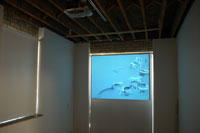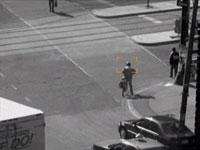InterAccess, This must be the place and David Rokeby
I have had the chance to see a number of photography shows in the last month, but I have decided to start my blog with a rather different one: This must be the place that marked the re-opening of InterAccess in September. I went to the opening of the show on the evening of September 15th with a friend of mine, and after walking for quite a while on Queen Street West, we both could not help saying to each other "this must be the place," when we finally reached the new building InterAccess is located at on 9 Ossington Avenue.
 InterAccess was founded in 1983 as a centre for artists interested in incorporating video, sound and interactive applications in their artworks, and it has been located at 401 Richmond for the last nine years. Their relocation at their own building, and this re-opening show are important in the sense that they show the growing interest and support for interactive media arts in Canada. The role of InterAccess in this growth is even more important, as it is an artist-run centre that provides production and research facilities for its members.
InterAccess was founded in 1983 as a centre for artists interested in incorporating video, sound and interactive applications in their artworks, and it has been located at 401 Richmond for the last nine years. Their relocation at their own building, and this re-opening show are important in the sense that they show the growing interest and support for interactive media arts in Canada. The role of InterAccess in this growth is even more important, as it is an artist-run centre that provides production and research facilities for its members.This must be the place is curated by Dana Samuel, and includes works by four artists: Vera Frenkel, David Rokeby, Nell Tenhaaf and Norman White. Worthy of Interaccess's reputation as the most prominent electronic media arts centre in Canada, the installations are all based around the idea of interactivity and the use of technology in art. Although all of the pieces incorporate interactive elements, Rokeby's Guardian Angel stood out for me as it offers some interesting juxtapositions between surveillance, voyeurism and photography.
David Rokeby is known for his innovative work in the field of interactivity and especially for softVNS, the real time video processing and tracking software he developed himself. He is a Toronto-based artist who studied at the Ontario College of Art, and his other works include Very Nervous System (1986-90) and Watched and Measured (2000).
 Guardian Angel, which was shown for the first time at the Images Festival in 2001, consists of a live video feed of the intersection that is right outside the gallery, and the projection of a computer processed version of this feed. The program prepared by Rokeby is able to analyze the movements inside the video, distinguish pedestrians from other objects, follow them visually using a tracking rectangle and take mugshots of them to be archived and shown together at specific intervals.
Guardian Angel, which was shown for the first time at the Images Festival in 2001, consists of a live video feed of the intersection that is right outside the gallery, and the projection of a computer processed version of this feed. The program prepared by Rokeby is able to analyze the movements inside the video, distinguish pedestrians from other objects, follow them visually using a tracking rectangle and take mugshots of them to be archived and shown together at specific intervals.The installation draws the viewer in by appealing to our need to be under surveillance, to feel secure in our environment, and to the pleasure we take from watching other people who are unaware of our gaze. The voyeuristic aspect of Guardian Angel is doubled when one realizes that the video shown on the screen is actually right outside the gallery, as it is now possible to locate the source, and even appear on the screen ourselves. This play between the reality and the projected image was taken to a new level on the night of the opening, when the images created by the program were projected on the windows of the gallery so they could be seen from the outside as well.
 The most striking moment of Guardian Angel is when the screen is filled up with all the mugshots it has taken and archived. That is when the viewer understands the power and the creepiness of automated surveillance; the program is in fact a relentless machine that can go on and on for years, collecting information, taking photos and saving them for future use. This is also how the piece refers to the history of photography, as photographical documents has been the most important surveillance method since their invention. Rokeby wants the spectator to think about the possibilities offered by technology today: What if the program was able to analyze body movements and classify them? What if it could use sound as well? What if it could recognize each person?
The most striking moment of Guardian Angel is when the screen is filled up with all the mugshots it has taken and archived. That is when the viewer understands the power and the creepiness of automated surveillance; the program is in fact a relentless machine that can go on and on for years, collecting information, taking photos and saving them for future use. This is also how the piece refers to the history of photography, as photographical documents has been the most important surveillance method since their invention. Rokeby wants the spectator to think about the possibilities offered by technology today: What if the program was able to analyze body movements and classify them? What if it could use sound as well? What if it could recognize each person? Guardian Angel points to some very important issues that are apparent in the western cultures today, such as our fascination with voyeuristic activities like reality television shows, and our comfort in the knowledge that we are being surveyed whether we are on the internet, or on the street, regardless of our choice. But I believe it is also important to note that Rokeby does not solely rely on our fascination with voyeurism in order to catch the viewer's attention. He beautifies the surveillance feed by using video effects that turn it into a gorgeous image, which shows the traces of every object or person that moves on the screen. I thought this aspect of Guardian Angel was problematic as it was commenting on the dangers of giving in to surveillance and on the invasion of privacy, but at the same time making what it criticized into something beautiful and fascinating. Of course, this contrast makes the work only more interesting and broadens the number of different meanings the spectator can take from it.
Guardian Angel points to some very important issues that are apparent in the western cultures today, such as our fascination with voyeuristic activities like reality television shows, and our comfort in the knowledge that we are being surveyed whether we are on the internet, or on the street, regardless of our choice. But I believe it is also important to note that Rokeby does not solely rely on our fascination with voyeurism in order to catch the viewer's attention. He beautifies the surveillance feed by using video effects that turn it into a gorgeous image, which shows the traces of every object or person that moves on the screen. I thought this aspect of Guardian Angel was problematic as it was commenting on the dangers of giving in to surveillance and on the invasion of privacy, but at the same time making what it criticized into something beautiful and fascinating. Of course, this contrast makes the work only more interesting and broadens the number of different meanings the spectator can take from it.
